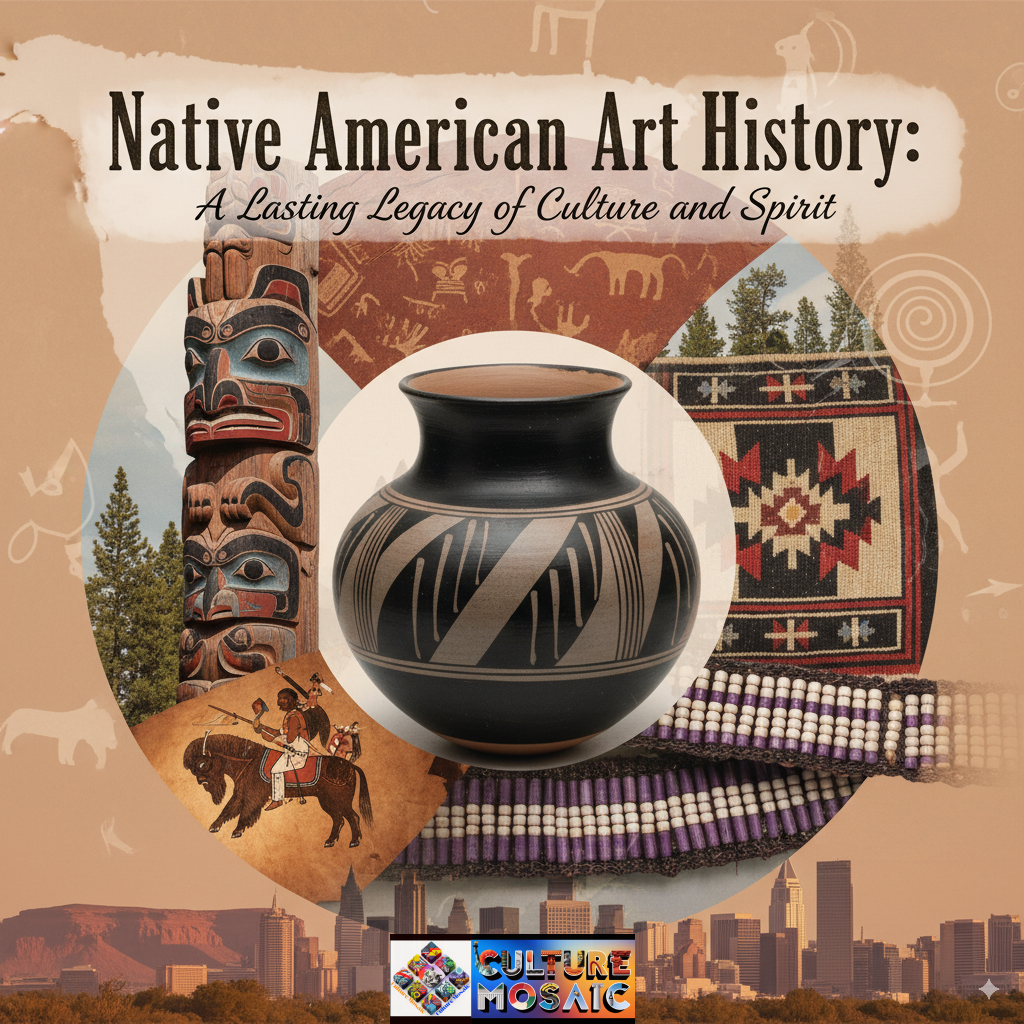Native American Art History: A Lasting Legacy of Culture and Spirit
Native American art history is a complex cultural story that has developed over thousands of years. From sacred symbols on pottery to beadwork to stunning totem poles, Native American art exhibits the beliefs, identities, and experiences of Indigenous Peoples all across North America.
In this article, we’ll be looking at the beginnings, styles, and spiritual meanings and merits of Native American art, from past to present, i.e., how it shows up in history and how it is still central to contemporary culture.
1. The Origins of Native American Art
Native American art is at least 10,000 years old, with early expressions being petroglyphs (rock carvings), pictographs (rock paintings), and woven fiber art. These works of art were not just for appearances’ sake—they functioned ceremonially, communicatively, and practically.
2. Diversity Across Tribes and Regions

With more than 570 federally recognized U.S. tribes alone, Native American art history is not uniform. Regional differences had a bearing on distinctive styles:
Southwest (e.g., Navajo, Hopi, Pueblo): Sand paintings, pottery, and woven rugs
- Pacific Northwest (e.g., Haida, Tlingit): Totem poles and cedar masks
- Great Plains (e.g., Lakota, Cheyenne): Buffalo hide paintings and beadwork
- Eastern Woodlands (e.g., Iroquois, Algonquin): Celebrated for their exquisite birchbark artistry and the symbolic storytelling power of wampum belts.
Each style corresponds to tribal traditions, local material, and environmental forces.
3. Symbolism and Spiritual Significance
Art was never “just art” to Native American cultures. Every piece was given religious meaning and narrative. Some of the recurring symbols are:
- Thunderbirds: Power and strength
- Spirals: Life cycles and travel
- Animals: Totemic representation of clans or spiritual guides
These signs would likely appear on clothing, adornments, drums, and structures.
4. The Significance of Oral Traditions in Art
Since most Native cultures were oral, art was a visual language. Narration through motifs, use of color, and shape enabled the passing down of ancestral knowledge, mythologies, and laws.
5. Traditional Art Materials

Materials employed by early Native artists were derived from their surroundings:
- Plant- and mineral-derived natural dyes and pigments
- Animal skin and feathers for regalia and ceremony purposes
- Wood, stone, and clay for sculpture and pottery
- Shells and beads for jewelry and embroidery
Sustainability and harmony with nature were intrinsic values in art and life.
6. Impact of Colonization on Native Art
European colonization disrupted traditional lifeways. Policies of forced assimilation, including residential schools, regularly prohibited Indigenous languages and art practices. Numerous sacred objects were lost or destroyed.
In spite of this, Native artists maintained their heritage through secret practices and modified forms of art—providing continuity even during cultural erasure.
7. The Vibrant Rebirth of Native American Art in the 20th Century
The 20th century saw a renaissance in the history of Native American art. Some artists who contributed to this renaissance include
- Maria Martinez (San Ildefonso Pueblo): Famous for her black-on-black pottery
- Oscar Howe (Yanktonai Sioux): Combined traditional subject matter with modernist aesthetics
- Jaune Quick-to-See Smith (Salish/Kootenai): Formed strong political collages
These artists redefined Indigenous art in the contemporary world.
8. Contemporary Native American Art
Native artists today work with identity, history, and activism in digital media, painting, sculpture, and performance art. The most well-known are
- Nicholas Galanin (Unangax̂/Tlingit): Subverts colonial histories through mixed media
- Wendy Red Star (Apsáalooke): Transforming Cultural Narratives with Photography
- Cannupa Hanska Luger (Mandan/Hidatsa/Arikara/Lakota): Intersects ceramic and video installations with social commentary
9. Native American Art in Museums and Galleries. Major institutions currently feature
Native exhibitions are in-house, yet repatriation and representation criticism continue. Tribally operated museums, including the Heard Museum and National Museum of the American Indian, provide more genuine interpretations based on community voices.
10. Why Native American Art Still Matters
Native American art history is not just about the past—it’s about living, breathing resilience and resistance. It continues to teach, motivate, and empower individuals from every background.
FAQs About Native American Art History
Q1: Which forms of Native American art date back to the earliest periods?
Petroglyphs and ceramics that date back thousands of years are some of the oldest known.
Q2: Why is symbolism so important in Native art?
It is religious, historical, and culturally significant—preserving tradition in visual form.
Q3: How did Native art survive colonization?
By adaptation, secrecy, and intergenerational transmission in spite of severe assimilation policies.
Q4: Are Native American artists well known globally today?
Indeed, others have become internationally recognized for their bold, culturally inspired works.
Q5: Where would one expect to encounter genuine Native American art?
Tribal museums, native art markets, and culturally sensitive exhibitions are good places to start.
Final Thoughts
To know the history of Native American art is not only to recognize the beauty of the work itself but also the heart of the cultures that created it. It is a history of survival, of adaptation, of ingrained identity—something that must be respected, learned from, and defended.

